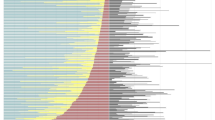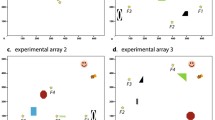Abstract
Foragers of the ant Formica schaufussitend to return to and search at a site of a previous food find. The search tactic employed by a forager on its return trip is related to the type of food previously encountered: search is more persistent in response to carbohydrate than to protein food. Using different reinforcement schedules with carbohydrate and protein food rewards, we show that, on a short-term as well as on a long-term basis, the basic pattern of search observed in naive foragers is only slightly modified through foraging experience. Foragers do not increase their search effort or adjust their search pattern when either type of food is systematically renewed on a fixed reward schedule and thus do not seem to be able to learn to assess the food predictability. Collective responses that could compensate for this lack of individual flexibility and increase foraging efficiency at the colony level are discussed.
Similar content being viewed by others
References
Bell, W. J. (1990). Searching behavior patterns in insects.Anna. Rev. Entomol. 35: 447–467.
Bell, W. J. (1991).Searching Behaviour: The Behavioural Ecology of Finding Resources, Chapman & Hall, New-York.
Beugnon, B., and Fourcassié, V. (1988). How do red wood ants orient when foraging in a three dimensional system? II. Field experiments.Ins. Soc. 105: 106–124.
Bristow, C. M. (1991). Are ant-aphid associations a tritrophic interaction? Oleander aphids and Argentine ants.Oecologia 87: 514–521.
Cartwright, B. A., and Collett, T. S. (1983). Landmark learning in bees. Experiments and models.J. Comp. Physiol. 151: 521–543.
Cartwright, B. A., and Collett, T. S. (1987). Landmark maps for honey bees.Biol. Cyber. 57: 87–93.
Dejean, A. (1985). Etude éco-éthologique de la prédation chez les fourmis du genreSmithistruma (Formicidae, Myrmicinae, Dacetini). IV. Le polyéthisme chezS. truncatidens.Ins. Soc. 32: 389–402.
Fewell, J. H. (1990). Directional fidelity as a foraging constraint in the western harvester ant,Pogonomyrmex occidentalis.Oecologia 82: 45–51.
Fourcassié, V. (1991). Terrestrial landmark orientation in natural situations in the red wood antFormica lugubris Zett. (Hymenoptera, Formicidae).Ecol. Ethol. Evolut. 3: 89–99.
Fourcassié, V., and Traniello, J. F. A. (1993). Food-searching behavior inFormica schaufussi: Responses of naive foragers to carbohydrate and protein food sourcesAnim. Behav., in press.
Fourcassié, V., Coughlin, D., and Traniello, J. F. A. (1992). Fractal analysis of search behavior in ants.Naturwissenschaften 79: 87–89.
Free, J. B. (1963). The flower constancy of honeybees.J. Anim. Ecol. 32: 119–131.
Fresneau, D. (1985). Individual foraging path fidelity in a ponerine ant.Ins. Soc. 32: 109–116.
Goss, S., Deneubourg, J. L., Pasteels, J. M., and Josens, G. (1989). A model of noncooperative foraging in social insects.Am. Nat. 134: 273–287.
Gould, J. L. (1984). Natural history of honey bee learning. In Marber, P., and Terrace, H. S. (eds.),The Biology of Learning, Springer Verlag, Berlin, Heidelberg, New York, Tokyo, pp. 149–180.
Harkness, R. D., and Maroudas, N. G. (1985). Central place foraging by an ant (Cataglyphis bicolor Fab.): A model of searching.Anim. Behav. 33: 916–928.
Heinrich, B. (1979).Bumblebee Economics, Harvard University Press, Cambridge, MA.
Hölldobler, B. (1976). Recruitment behavior, home range orientation and territoriality in harvesting antsPogonomyrmex.Behav. Ecol. Sociobiol. 1: 3–44.
Hölldobler, B., and Wilson, E. O. (1990).The Ants, Beknap Press of Harvard University Press, Cambridge, MA.
Jander, R. (1975). Ecological aspects of spatial orientation.Annu. Rev. Ecol. Syst. 6: 171–188.
Johnson, R. A. (1991). Learning, memory, and foraging efficiency in two species of desert seed- harvester ans.Ecology 72: 1408–1419.
Johnston, T. D. (1981). Contrasting approaches to a theory of learning.Behav. Brain Sci. 4: 125–139.
Laverty, T. M. (1980). The flower-visiting behavior of bumble-bees: Floral complexity and learning.Can. J. Tool. 58: 1324–1335.
Menzel, R. (1984). Learning in honeybees in a behavioral and ecological context. In Hölldobler, B., and Lindauer, M. (eds.),Experimental Behavioral Ecology and Sociobiology, Fortschritte der Zoologie, Gustav Fisher, Stuttgart, New York, Vol. 31, pp. 55–74.
Menzel, R. (1990). Learning, memory, and cognition in honey bees. In Kesner, R. P., and Olton, D. S. (eds.),Neurobiology of Comparative Cognition, Lawrence Erlbaum Associates, Hills-dale, NJ.
Papaj, D. R., and Prokopy, R. J. (1989). Ecological and evolutionary aspects of learning in phytophagous insects.Annu. Rev. Entomol. 34: 315–350.
Rissing, S. W. (1981). Foraging specializations of individual seed-harvesting ants.Behav. Ecol. Sociobiol. 9: 149–152.
Rosengren, R. (1971). Route fidelity, visual memory and recruitment behavior in foraging ants of the genusFormica (Hymenoptera, Formicidae).Acta Zool. Fenn. 133: 1–150.
Rosengren, R., and Fortelius, W. (1986). Ortstreue in foraging ants of theFormica rufa group-Hierarchy of orienting cues and long-term memory.Ins. Soc. 33: 306–337.
Schmid-Hempel, P. (1984). Individually different foraging methods in the desert antCataglyphis bicolor (Hymenoptera: Formicidae).Behav. Ecol. Sociobiol. 19: 263–271.
Seeley, T. D., and Levien, R. A. (1987). Social foraging by honeybees: How a colony tracks rich sources of nectar. In Menzel, R., and Mercer, A., (eds.),Neurobiology and Behavior of Honeybees, Springer Verlag, Berlin, pp. 38–53.
Sokal, R. R., and Rohlf, F. J. (1981).Biometry—The Principles of Statistics in Biological Research, W. H. Freeman, San Francisco.
Sudd, J. M., and Sudd, M. E. (1985). Seasonal changes in the response of wood-ants (Formica lugubris) to sucrose baits.Ecol. Entomol. 10: 89–97.
Traniello, J. F. A. (1987). Cooperative foraging ecology of north temperate ants: The role of worker size and cooperative foraging in prey selection.Ins. Soc. 34: 118–130.
Traniello, J. F. A. (1988). Variation in foraging behavior among workers of the antFormica schaufussi: Ecological correlates of search behavior and the modification of search pattern. In Jeanne, R. L. (ed.),Interindividual Behavioral Variability in Social Insects, Westview Press, Boulder, CO, pp. 91–112.
Traniello, J. F. A. (1989). Foraging strategies of ants.Annu. Rev. Entomol. 34: 191–210.
Traniello, J. F. A., and Beshers, S. N. (1991). Maximization of foraging efficiency and resource defence by group retrieval in the antFormica schaufussi.Behav. Ecol. Sociobiol. 29: 283–289.
Traniello, J. F. A., Fourcassié, V., and Graham, T. P. (1991). Search behavior and foraging ecology of the antFormica schaufussi: Colony-level and individual patterns.Ethol. Ecol. Evolut. 3: 35–47.
Waser, N. M. (1986). Flower constancy: Definition, cause and measurement.Am. Nat. 127: 593–603.
Weaver, N. (1956). The foraging behavior of honeybees on hairy vetch: Foraging methods and learning to forage.Ins. Soc. 3: 537–549.
Wehner, R., Harkness, R. D., and Schmid-Hempel, P. (1983). Foraging strategies in individually searching ants,Cataglyphis bicolor (Hymenoptera, Formicidae). In Lindauer, M. (ed.),Information Processing in Animals, Vol. 1, Akademie der Wissenschaften und der Literatur Mainz, Gustav Fisher, Stuttgart, New York.
Wehner, R., and Menzel, R. (1990). Do insects have cognitive maps?Annu. Rev. Neurosci. 13: 404–414.
Winer, B. J. (1971).Statistical Principles in Experimental Design, McGraw-Hill, New York.
Author information
Authors and Affiliations
Rights and permissions
About this article
Cite this article
Fourcassié, V., Traniello, J.F.A. Effects of experience on food-searching behavior in the antFormica schaufussi (Hymenoptera: Formicidae). J Insect Behav 6, 287–299 (1993). https://doi.org/10.1007/BF01048110
Accepted:
Issue Date:
DOI: https://doi.org/10.1007/BF01048110




